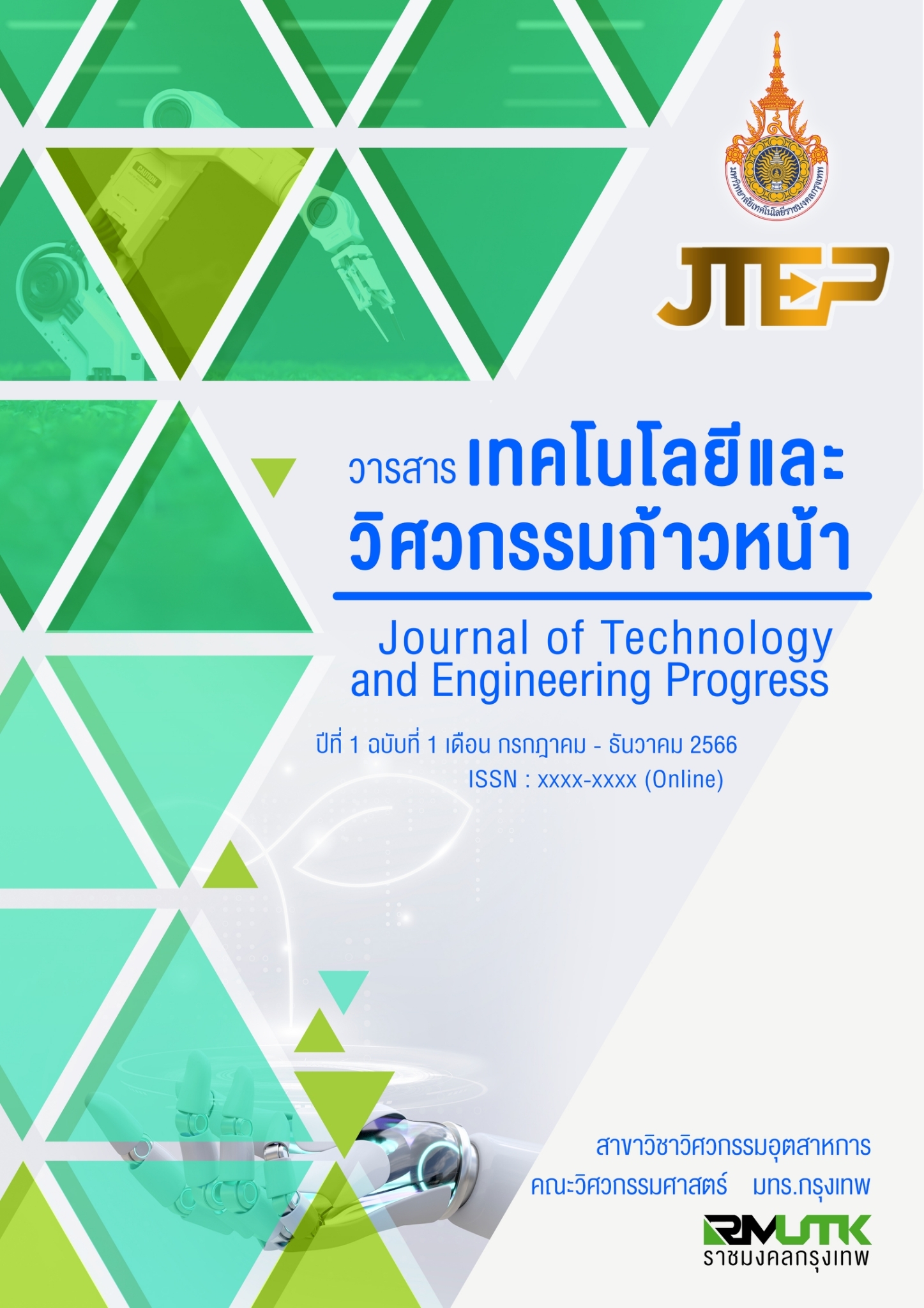Comparative on the Effect of Wire Drawing Condition for Wire Drawing Process of Aluminum Alloy AA5052
Main Article Content
Abstract
The aim of this research was to comparative study on the effect of the aluminum alloy grade 5052 wire drawing conditions, which consisted of die approach angle, lubricant type and wire drawing speed, that affects to the wire drawing force and the finished wire quality. The wire drawing dies are made of tungsten carbide grade K20 (ISO Code). There are 3 different size of die approach angles: 16°, 18° and 20°. The aluminium wire before drawing has a diameter of 2.0 mm., wire drawing with a cross-sectional reduction ratio of 10%, used of 3 different viscosity lubricants and 3 drawing velocity. Experiment and analyze on the drawing force, surface roughness and tensile strength of the finished wire. The experiment results showed that wire drawing by a die with an approach angle of 16° at a drawing velocity of 0.1 m/s and using lubricant DN Press Draw40 grade gave the best wire surface finish. The drawing by a large die approach angle and uses a low velocity speed Will use the higher drawing force and provide a stronger wire. Which is caused by the effect of redundance deformation. As for wire drawing through a small die approach angle size and a high drawing velocity, use the lower drawing force, the finished wire has less strength. As for the effects of lubricants, it is found that the wire drawing by the lubricants with low viscosity will use a higher drawing force. Finish wire, which has lower a surface roughness and tensile strength.
Article Details

This work is licensed under a Creative Commons Attribution-NonCommercial-NoDerivatives 4.0 International License.
Journal of Technology and Engineering Progress is licensed under a Creative Commons Attribution-NonCommercial-NoDerivatives 4.0 International (CC BY-NC-ND 4.0) licence, unless otherwise stated. Please read our Policies page for more information
References
T. Viktor. “Steel Wire Production by Cold Drawing”, Hochschule Anhalt. Vol. 1, 2010, pp. 70-83.
G. FEDORKO, V. MOLNÁR, N. HUSÁKOVÁ, M. WEISZER. “Analysis of forces in steel wire rope of mining hoisting machine passing sheave”, In: 4th Balkan Mining Congress: 18th-20th October 2011, Ljubljana, 2011, pp. 235-238.
J. BOROŠKA , V. MOLNÁR, G. FEDORKO, “Vplyv priemeru drôtu ocelového lana na jeho skutočné napätie”, Doprava a logistika, Vol. 8, 2005, pp. 5-15.
G. Vega, A. Haddi, A. Imad, “Temperature effects on wire-drawing process: Experimental investigation”, International Journal of Material Forming, 2009, : DOI: 10.1007/s12289-009-0468-y
F.A.Hashim, S.M.Ihmood, K.A. Mohammed, “Microstructural Investigation of Wire Failure in Wire Drawing Process”, University of Thi-Qar Journal, Vol.14 (1), 2019, pp. 53-62.
U.S. Dixit, P.M. Dixit, “An analysis of the steady-state wire drawing of strain hardening materials”, Journal of Material Process Technology, Vol. 47, 1995, pp. 201–29.
M. Suliga, R. Kruzel, T. Garstka. (2015). “The influence of drawing speed on structure changes in high carbon steel wires”,J. Gazdowicz Metalurgija, Vol. 54, pp. 161–164.
S. M. Byon, S. J. Lee, D. W. Lee, Y. H. Lee, and Y. Lee, “Effect of coating material and lubricant on forming force and surface defects in wire drawing process,” Trans. Nonferrous Met. Soc. China English Ed., vol. 21(1), 2011, pp. s104–s110.
S.M. Dhaher, “Preparation of Dry Solid Lubricant for Drawing of Welding Steel Wires from Local Iraqi Materials,” Al - Mustansiriya J. Sci, vol. 20 (5), 2009, pp. 28–34.
M. T. Hillery and V. J. Mccabe, “precessh g Materials Wire drawing at elevated temperatures using different die materials and lubricants IAVOmeter Pyrometer,” J. Mater. Process. Technol, vol. 55, 1995, pp. 53–57.
S. M. Hafis, M. J. M. Ridzuan, A. Rahayu, Mohamed, R. N. Farahana, and S. Syahrullail, “Minimum quantity lubrication in cold work drawing process: Effects on forming load and surface roughness,” Procedia Eng., vol. 68, 2013, pp. 639–646.
E.K. Saied , N.I. Elzeiny, H.T. Elmetwally, A.A. Abd-Eltwab, “An Experimental Study of Lubricant Effect on Wire Drawing Process”, International Journal of Advanced Science and Technology, Vol. 29 (1), 2020, pp. 560–568.
E. Siebel, R. Kobitzsch, “Die Erwarmung des Ziehgutes beim Drahtziehen”. Stahl U. Eisen(63), 1943, pp. 110-113.
G. Vega , A. Haddi, A. Imad, “Temperature effects on wire-drawing process: experimental investigation”, Int. J. Mater. Vol.2, 2009, pp. 229–232.
M. Suliga, R. Kruzel, T. Garstka, “The influence of drawing speed on structure changes in high carbon steel wires”, J. Gazdowicz, Metalurgija, Vol.54, 2015, pp. 161–164.
A.F. Gutsol, “Improving ASTM D445, the Manual Viscosity Test, by Video Recording”, Journal of Testing and Evaluation, Vol. 47 (1), 2019, pp. 310-323.
J.Larsson, A. Jansson, P.Karlsson, “Monitoring and evaluation of the wire drawing process using thermal imaging” The International Journal of Advanced Manufacturing Technology, Vol.101, 2019, pp. 2121–2134.
Z. Muskalski, S. Wiewiórowska, “The Theoretical Analysis of Wire Drawing Process for Hydrodynamic Friction Conditions” Metallurgical and Mining Industry, Vol. 3 (7), 2011, pp. 74-78.
E.K. Saied, N.I. Elzeiny, H.T. Elmetwally, A.A. Abd-Eltwab, “An Experimental Study of Lubricant Effect on Wire Drawing Process”, International Journal of Advanced Science and Technology, Vol. 29 (1), 2020, pp. 560 – 568.
M. Suliga, “The influence of drawing speed on surface topography of high carbon steel wires”, Metalurgija, Vol. 56, 2017, pp. 182–184.
M.M. Mahdavi, H. Haghighat, “On the Optimum Die Angle in Rod Drawing Process Considering Strain-hardening Effect of Materia” Iranian Journal of Mechanical Engineering, Vol. 20(1), 2019, pp.113-128.

